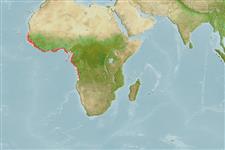Environment: milieu / climate zone / depth range / distribution range
Ecologie
marien demersaal; diepte 80 - 300 m (Ref. 3589). Tropical; 17°N - 13°S, 19°W - 15°E (Ref. 5222)
Eastern Atlantic: Mauritania (Ref. 5377) and Senegal to southern Angola.
Grootte / Gewicht / Leeftijd
Maturity: Lm ? range ? - ? cm
Max length : 140 cm TL mannelijk / geslacht onbekend; (Ref. 5377); common length : 50.0 cm TL mannelijk / geslacht onbekend; (Ref. 26999)
Dorsale stekels (totaal) : 11; Dorsale zachte stralen (totaal) : 16; Anale stekels: 3; Anale zachte stralen: 8. Distinguished by the following characteristics: brownish head and body; 3-4 broad oblique bars on the dorsal part of the body and another on the dorsal half of the peduncle; 2 narrow faint dark bands extending posteriorly from the lower half of the eye; presence of dark moustache streak, not extending past the rear end on maxilla; body depth less than head length, depth contained 2.9-3.2 times in SL; head length 2.5-2.7 times in standard length; flat or slightly convex interorbital area; angular preopercle, 3-4 enlarged serrae at the angle, lowermost directed ventrally; serrate interopercle and subopercle; well developed middle and lower opercular spines, upper spine not apparent; approximately straight upper edge of operculum; maxilla reaches vertical at rear edge of eye; maxilla naked or with few minute scales dorsally; 2 rows of teeth on midlateral part of lower jaw; posterior nostril about twice the size of anterior nostril (Ref. 89707).
Reported to occur from a variety of habitats (rock, mud and sand). The adults live in relatively deeper waters (Ref. 5377). Little is known about its biology.
Levenscyclus en paargedrag
Maturiteit | Voortplanting | Paaien | Eieren | Fecunditeit | Larven
Heemstra, P.C. and J.E. Randall, 1993. FAO Species Catalogue. Vol. 16. Groupers of the world (family Serranidae, subfamily Epinephelinae). An annotated and illustrated catalogue of the grouper, rockcod, hind, coral grouper and lyretail species known to date. Rome: FAO. FAO Fish. Synop. 125(16):382 p. (Ref. 5222)
Status op de Rode Lijst van het IUCN (Ref. 130435: Version 2024-1)
Gevaar voor de mens
Harmless
Gebruik door de mens
Visserij: visserij voor eigen gebruik
Tools
Speciale rapporten
Download XML
Internetbronnen
Estimates based on models
Preferred temperature (Ref.
123201): 14.2 - 16.4, mean 15.3 °C (based on 16 cells).
Fylogenetische diversiteitsindex (Ref.
82804): PD
50 = 0.5000 [Uniqueness, from 0.5 = low to 2.0 = high].
Bayesian length-weight: a=0.01072 (0.00588 - 0.01953), b=3.03 (2.88 - 3.18), in cm total length, based on LWR estimates for this species & Genus-body shape (Ref.
93245).
Trofisch niveau (Ref.
69278): 3.9 ±0.64 se; based on food items.
Weerstandsvermogen (Ref.
120179): Gemiddeld, minimale populatieverdubbelingstijd 1,4-4,4 jaar (Assuming tm=3-4).
Fishing Vulnerability (Ref.
59153): Very high vulnerability (84 of 100).
Climate Vulnerability (Ref.
125649): Very high vulnerability (83 of 100).
Nutrients (Ref.
124155): Calcium = 42.3 [16.9, 97.0] mg/100g; Iron = 0.731 [0.329, 1.668] mg/100g; Protein = 17.7 [16.0, 19.2] %; Omega3 = 0.187 [0.095, 0.360] g/100g; Selenium = 97.9 [44.0, 230.9] μg/100g; VitaminA = 30.3 [7.3, 126.4] μg/100g; Zinc = 1.03 [0.64, 1.70] mg/100g (wet weight);
